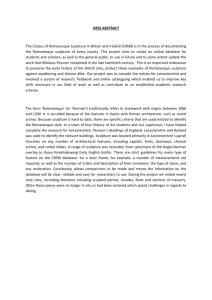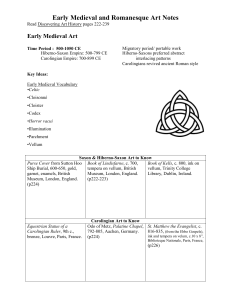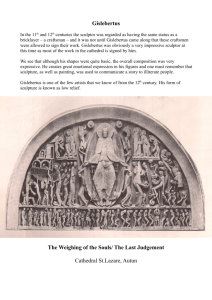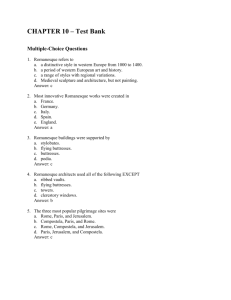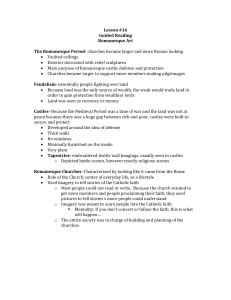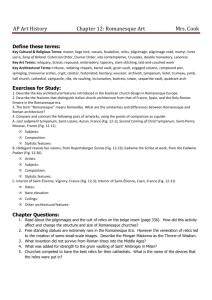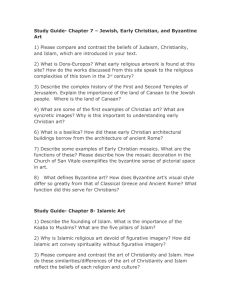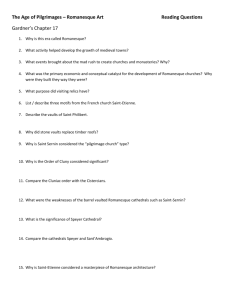LSMS Art History LC:Layout 1
advertisement
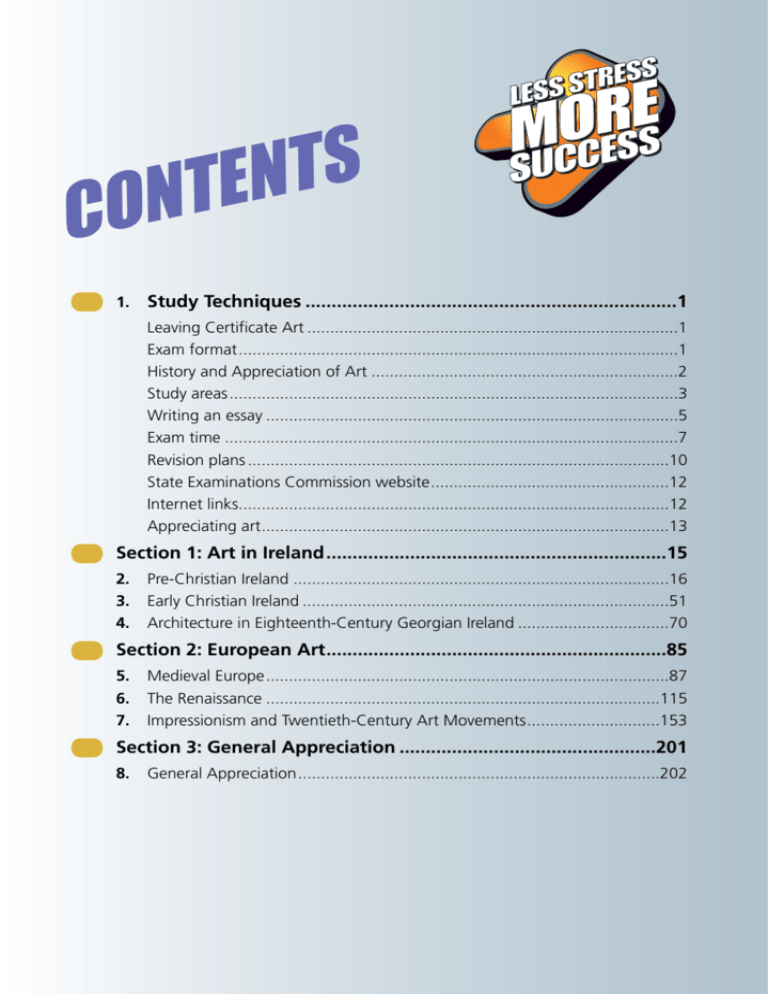
S T N E T N O C 1. Study Techniques .......................................................................1 Leaving Certificate Art .................................................................................1 Exam format................................................................................................1 History and Appreciation of Art ...................................................................2 Study areas..................................................................................................3 Writing an essay ..........................................................................................5 Exam time ...................................................................................................7 Revision plans ............................................................................................10 State Examinations Commission website....................................................12 Internet links..............................................................................................12 Appreciating art.........................................................................................13 Section 1: Art in Ireland.................................................................15 2. 3. 4. Pre-Christian Ireland ..................................................................................16 Early Christian Ireland ................................................................................51 Architecture in Eighteenth-Century Georgian Ireland .................................70 Section 2: European Art.................................................................85 5. 6. 7. Medieval Europe........................................................................................87 The Renaissance ......................................................................................115 Impressionism and Twentieth-Century Art Movements.............................153 Section 3: General Appreciation .................................................201 8. General Appreciation...............................................................................202 5 Medieval Europe Romanesque art and architecture: Eleventh and twelfth centuries Romanesque art dominated virtually all of Western Europe from around A.D. 1000 until around A.D. 1200. Romanesque art originated in France but it made a strong impact in Italy and Germany also. The term ‘Romanesque’ literally means ‘Roman-like’ and it was first used in the eighteenth century by a French art expert. The term has been used to describe this style ever after. Life in Medieval Europe Life in Medieval Europe saw some interesting social changes, including: G G G G G There was a deep belief in the afterlife throughout all levels of society in Medieval Europe. In a time of great piety, religious observance controlled every aspect of daily life from the cradle to the grave. Growth in the economy. Renewed energy in learning, philosophy and technology. A huge building boom, particularly in churches. Stronger social influence from the church and monastic orders. Deep engagement with spiritual matters: pilgrimages, devotion to the saints, a reverence towards religious relics, etc. Building of churches There was a dramatic increase in the number of churches built at this time. G Cluny Abbey in France was rebuilt in the new Romanesque style. The new millennium had an effect on Medieval European society. There was a widespread fear that the world would end in the year A.D. 1000 and this led to a great deal of pessimism about the future during the late 900s. Pilgrimage routes throughout France 88 LESS STRESS MORE SUCCESS G G Pilgrimages became very popular, e.g. Santiago de Compostela in Spain. As a result, many new churches were built along the four main pilgrimage routes. Churches along the pilgrimage routes were built in stone and were very similar in design. Architecture G G G G G G G G G G G G Blocky in shape, giving a solid geometrical appearance. Cruciform-shaped ground plan based on the Roman basilica shape with added crosswise transepts. Rounded arches (based on Roman arches). Stone roofs needed to combat the problem of fire. Barrel vaulting, which developed into groin vaulting in later times. Outward thrust caused by pressure from the heavy stone roof. Very thick walls to support heavy vaults. Solid rounded pillars to support stone roofs. Dark interiors caused by the high, small windows. Ambulatory for pilgrims to walk around. A ring of smaller chapels called radiating chapels (rayonnant in French) extending out from the ambulatory. Large western façades with semi-circular tympanum over the door. St Foy of Conques, a typical Romanesque church Barrel and groin vaults were supported in the middle by transverse arches, but the heavy stones pushed down on the arches, causing them to flatten and the walls to buckle outward. This pressure outward is known as outward thrust. chancel apse choir transept crossing Abutment Barrel vault Barrel vault keystone voussoir nave Barrel vault impost aisle N pier foundation Groin Groin vault Groin vault Romanesque arch Plan of St Sernin, Toulouse MEDIEVAL EUROPE 89 Sculpture G G G G G G G G G Architectural sculpture served the purpose of educating the people. Relief sculpture features in the tympanum. The Last Judgment is a common theme. Grotesque imagery is a feature throughout. Carved capitals appear on supporting pillars. Sculpture was painted at the time. The art is quite abstract and very little realism was attempted. Foliage (plants) and drapery (clothing) were treated in a very decorative manner with swirling patterns. Figures are sometimes blocky but often elongated. Exam questions are unlikely to focus on Romanesque architecture alone. It is more common to be asked about the relationship between Romanesque architecture and sculpture, or for a comparison of Romanesque and Gothic styles. It is not enough to be familiar with just one example of Romanesque sculpture. The exam question may ask you to discuss several examples, so study each of the following: tympanum and capitals in Autun; tympanum and capitals in Vézelay; and tympanum in St Foy. Useful resources G G Visit www.sacred-destinations.com, following the links for Cluny, Autun, Vézelay and Conques. You will find excellent illustrations and descriptions of important sites of church architecture and sculpture. Visit www.wga.hu. Use the search facility to find Gislebertus and you’ll see wonderfully detailed images of the tympanum at Autun. You should also search for Vézelay. St Foy de Conques St Foy de Conques is a typical Romanesque pilgrimage church. It was a popular stopping point for pilgrims on the way to Santiago de Compostela. The church houses the relic of St Foy, a young woman martyred for her faith. Architecture G G G G G G Blocky and geometric in appearance. Rounded arches on windows, doorways and supporting piers. Thick walls support a high stone barrel-vaulted roof. Small windows make the interior quite dark. A very large dome over the crossing brings in good light. The main western façade is large, simple and geometric in design. 90 LESS STRESS MORE SUCCESS Sculpture G G G G G G G A tympanum over the main door has a relief sculpture of the Last Judgment. This is a particularly expressive scene, with Christ in the centre raising his hand in blessing. To the right of Christ is a detailed depiction of heaven, with realistic figures of the apostles and a procession of saints. To the left of Christ is a graphic depiction of the torment of sinners condemned to hell. The upper level shows the weighing of souls and beyond the gates below are devils pushing the damned into snarling jaws. Medieval architectural sculptures like the Last Judgment at St Foy An inscription in Latin translates as: are sometimes referred to as ‘O sinners, if you do not mend your ways, ‘sermons in stone’. know that you will suffer a dreadful fate.’ The sculpture was originally painted and some colour is still visible on sheltered spots. St Magdalene, Vézelay This is the largest Romanesque church in France. It was a Benedictine abbey overseen by Cluny and it housed a relic of Mary Magdalene. It was officially listed by Cluny as a major stopping point on the route to Santiago de Compostela. Architecture G G G Exterior damaged during the French Revolution. Interior very well preserved. Rebuilt around A.D. 1150, after a fire killed twelve hundred pilgrims. Interior G G G G G G Groin-vaulting. Rounded arches divide the nave. Ochre and white stone on the arches give a unique chequered effect. Arches supported with square piers with engaged (attached) rounded pillars on each side. Noticeable sagging outwards of the walls (outward thrust). Buttresses later added to the exterior to prevent further outward thrust. Sculpture Tympanum G G G Carved relief sculpture on the tympanum inside the narthex (porch). The tympanum sculpture depicts the Pentecost or descent of the Holy Spirit upon the apostles fifty days after the resurrection of Christ. The large figure of Christ is enclosed in a mandorla (oval halo) with arms open. MEDIEVAL EUROPE The light of the Holy Spirit falls from Christ’s hands onto the heads of the apostles. G Above and below Christ is a representation of all of humanity. Carved capitals in the Nave G Capitals in the nave are carved on three sides and the imagery is typically Romanesque in its fascination with the grotesque. G The Mystic Mill is Vézelay’s most famous capital. It shows Moses pouring grain (which symbolises the law) into a mill (symbolising Christ), while St Paul the Apostle gathers the flour. 91 G Tympanum at St Magdalene at Vézelay St Lazare, Autun St Lazare is one of the most important Romanesque churches in France. It was built in the mid-twelfth century. Some later Gothic additions were needed–the great spire was added after a fire in the fifteenth century–but the core of the church remains Romanesque. It is famous for its wonderful sculptures by Gislebertus. Sculpture Tympanum G Carved relief sculpture on the west tympanum. The Mystic Mill, capital at Vézelay G The tympanum sculpture depicts the Last Judgment. G In the centre, Christ sits impassively inside a The simplicity of the storytelling sculpture at great mandorla held by angels. Autun tends to appeal to the G An inscription in Latin below Christ’s feet modern viewer not just identifies the sculptor with the words because of its intensity but ‘Gislebertus hoc fecit’ or ‘Gislebertus made this’. because its expressive, elongated figures have a G To Christ’s right, the apostles incline their heads distinctly abstract quality. towards him. G St Peter holds a large key and turns to welcome the souls of the saved into heaven. G On the lintel below, all the souls arise from their coffins. G An angel with a flaming sword separates the saved from the damned. G The saved on Christ’s right rejoice and look towards him, while the souls of the damned stumble off naked. G Amongst the saved, an angel guides three children upwards. G Two pilgrims walk upwards towards Christ. They carry bags showing symbols: the cross for the pilgrimage to Jerusalem and a scallop shell representing Santiago de Compostela. 92 LESS STRESS MORE SUCCESS G G G G G Among the damned is a miser with heavy money bags and an adulteress with snakes gnawing at her. A pair of giant hands grips a tormented soul to pull it upwards. The weighing of souls is depicted. Archangel Michael leans on the scales to help them go in the right direction. A devil sits in the scales and another pulls on it to make it heavier. Souls are poured down the chute into the jaws of hell, while a devil leans out to torment them. The tympanum at Autun was plastered over in the mid-eighteenth century because the church had grown embarrassed by its harsh imagery. The head of Christ was sticking out so it was hacked off. The plaster was removed in 1837 and Christ’s head was found in a local museum in 1948. Because the tympanum was plastered over it survived the Revolution, while many other artworks were lost. Tympanum at Autun Pilgrims detail, tympanum at Autun Carved Capitals G G G G The capitals show Gislebertus’ skills as a sculptor and storyteller. Some of the best examples can be seen on the pillars of the choir, which was replaced after a fire and is now in the museum of the cathedral. The Suicide of Judas is a famous carved capital. It depicts Judas hanging himself after betraying Jesus. Hideous devils pull on Judas’s rope. The horror of the event contrasts with a beautifully depicted ornamental tree and the scene fits neatly into the shape of the capital. The Dream of the Magi, Autun The Dream of the Magi is another fascinating capital. Few details convey the message of the scene very clearly. Here we see the angel pointing to the star of Bethlehem. The three kings sleep in one cosy bed, wearing their crowns. The angel gently touches the hand of one sleeping king, warning him not to return to Herod but to follow the star. The king wakes from his sleep, one eye open. MEDIEVAL EUROPE 93 SAMPLE EXAM QUESTION Describe and discuss in detail the work of Gislebertus. Refer to the stylistic, narrative and expressive qualities of the work. SAMPLE ANSWER We may have never known it was Gislebertus who sculpted some of the most beautiful work in the twelfth century if it were not for the tympanum in the Cathedral of St Lazare in Autun in France. In an extremely rare occurrence in medieval art, the inscription ‘Gislebertus Hoc Fecit’ (‘Gislebertus made this’) appears on the sculpture beneath the feet of Christ, suggesting that this is the signature of the artist. During the Romanesque period, the church was the most powerful institution and Church leaders encouraged people to make pilgrimages to Santiago de Compostela in northern Spain. Building was booming as roads, bridges and particularly churches were built to serve the needs of the thousands of pilgrims on the move throughout Europe. Romanesque The word ‘Romanesque’ means ‘Roman-like’ and these churches were designed like older Roman basilicas. Church building reached great heights in France where five new churches were built on each of four main pilgrimage routes. One of these was at Autun in the Burgundy region. Autun A large carved scene on the great semicircular tympanum over the main doorway at Autun depicts the Last Judgment. Such a scene would not have been unusual, but the grotesque imagery here is particularly dramatic and realistic. It was most probably sculpted to scare pilgrims to change their ways lest they be destined for hell. Part of this scene includes the Weighing of Souls, which is probably the most famous of all Romanesque sculptures. A huge figure of a judgmental God sits on a throne in the centre, while underneath the souls rise from their tombs as angels sound the last trumpet. To the right of God, Peter welcomes the saved souls to heaven; to the left of God, hideous devils wrestle for the souls of those who are being weighed before the damned are dragged off to hell by grotesque demons.
